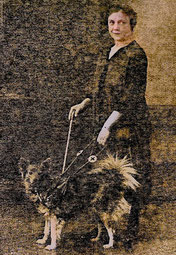The Spitz as guide dog

The Spitz as a guide dog? Are you serious? Oh, yes - Spitzes were used as guide dogs for the blind in the past. This is how Dr. Hans Haupt in "Die Geschichte der Blindenhunde" (The History of Guide Dogs), which was published in Wiesbaden, describes a young Austrian who got a German Spitz as a guide dog:
In Paris in the 18th century there was an institute, the "Les Quinze-Vingts" hospital for the blind, whose blind patients were led through the streets of the city by dogs. The reputation of this institution reached as far as Vienna, where in 1780 a Josef Reisinger became blind at the age of 20. After eight years he got a dog and this dog was a Spitz that had been specially trained to walk in front of its master - and not at the side of humans as in the Paris Hospital for the Blind.
After a year of training, Reisinger's Spitz performed so well that passers-by sometimes believed that Reisinger was not really blind, but was just pretending to arouse pity and thus receive more alms. That Spitz served his master until old age.
Another testimony to the use of the German Spitz as a guide dog can be found in the 1847 book by the Swiss Jakob Birrer. In it, he describes his method for training a dog to become a guide dog in detail - and also here the author firstly speaks of a Spitz who served him as a guide dog for five years:

"About 4–5 years ago I heard that some blind people in Paris had a poodle as a guide dog, but that didn't seem credible to me. On this occasion I said that I didn't want to have a dog as a guide; but I did, two years ago I came up with the idea of carrying out the test myself with a Spitz […].
[...] To say a word about the poodles, I admit that they are the best breed for training, as they can also be trained in other amusing arts; but they require their own education. While a Spitz dog has endurance, even on long hikes, the poodle can only be used to some extent in cities, and even then often only as a toy dog, and is also sluggish, especially in summer. He has great sensitivity and suffers no punishment. Not only would I prefer the Spitzer to the Poodle because he has more endurance, but also because it is easier to train; The only thing you have to make sure with this breed is that the animal is ten, but not more than sixteen months old and, to avoid great embarrassment, of male type."*
Birrer's method was based primarily on using punishment to make the dog understand what he should do and what he should not do. However, praise and reward also served as essential means of dressage.

After these initial approaches to using dogs for blind people were initially forgotten, after the outbreak of the First World War - due to the large number of veterans who became blind due to injuries at the front - the Viennese doctor Dr. L. Senfelder suggested giving these blind men a guide dog. However, this suggestion was initially not heard in Austria. The idea of the guide dog for the blind came to Germany through Privy Councilor Heinrich C. Stalling, the chairman of the “Deutschen Vereins für Sanitätshunde” (German Association for Medical Dogs). With the support of the War Ministry, he founded the world's first guide dog school in Oldenburg in August 1916 and the first guide dog was handed over in October 1916. However, other, supposedly more suitable breeds were used for this purpose, such as the German Shepherd.
However, at the general meeting in 1920, the training of guide dogs was included in the statutes of the "Verein für Deutsche" Spitze (German Spitz Club) as a further purpose of the association.

In 1985, the Czechoslovakian magazine PES (No. 3/85) reported on a Wolfspitz named Tim who had been trained as a guide dog. His owner, Milena Matouschek, gradually went blind over the course of 9 years, so she urgently needed a guide dog. However, due to a terrible incident in her youth, she had an insurmountable fear of German Shepherds - and so she came to the Wolfsspitz. After a lot of back and forth, Tim was trained as a guide dog by the responsible association. At the beginning, however, hardly anyone had any hope that the training could be successful, as it is known that the Spitz has a different personality than a German Shepherd: it can be very stubborn and defiant. On the other hand, the German Spitz is also particularly affectionate and friendly towards his master and mistress, and is therefore quite willing to do everything for them. After seven months it was done: Tim was a trained and good guide dog for his mistress Milena.
Interesting fact: Until the First World War, guide dogs were usually trained by the blind people themselves, quite the opposite of today's approach. Nowadays, the dogs are only handed over to the blind after training at the guide dog school, which rarely works - also because the dogs no longer work well relatively quickly if the new owner does not continue the training.
*"Erinnerungen, merkwürdige Lebensfahrten und besondere Ansichten des Jakob Birrer" (Memories, strange life journeys and special views of Jakob Birrer), H. Nägeli, 1844, p. 158 and 162
23.08.23




